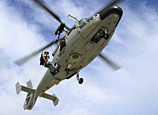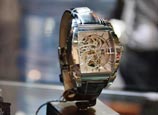
 |
| Astronauts Zhang Xiaoguang, Nie Haisheng and Wang Yaping (from left to right) wave after getting out of the re-entry capsule of China's Shenzhou-10 spacecraft following its successful landing at the main landing site in north China's Inner Mongolia Autonomous Region on June 26, 2013. (Xinhua/Zhang Ling) |
BEIJING, June 26 (Xinhua) -- Three astronauts who completed China's longest manned space mission returned to Earth safely Wednesday morning, marking another step forward towards the country's goal of building a permanent manned space station by 2020.
Zhang Youxia, commander-in-chief of China's manned space program, said the Shenzhou-10 mission was a "complete success".
The reentry module of Shenzhou-10 landed safely on a sun-lit prairie in north China's Inner Mongolia Autonomous Region at about 8:07 a.m. Wednesday. All three astronauts were in good physical condition.
Nie Haisheng, commander of the Shenzhou-10 crew and a second-time space traveler, was the first to emerge out of the bowl-like module, followed by Wang Yaping, the only female astronaut of the mission, and Zhang Xiaoguang.
During a brief welcoming ceremony held at the landing area, the astronauts waved merrily to a crowd composed of military officers, the search and recovery team, and health personnel.
"It feels really good to be back home," said astronaut Nie Haisheng.
"We are dreamers, and we have now fulfilled our dream," said Zhang Xiaoguang. "Our space dream knows no boundary, and our hard work will never cease," he said.
Vice Premier Zhang Gaoli arrived at the Beijing Aerospace Control Center Wednesday morning and watched the live broadcast of the return and recovery of Shenzhou-10 there.
Zhang delivered a congratulatory note on behalf of the Communist Party of China Central Committee, the State Council, and the Central Military Commission, celebrating the success of the Shenzhou-10 mission.
The Shenzhou-10 is China's first application-oriented space flight.
Compared with its previous mission Shenzhou-9 last year, the Shenzhou-10 is no longer experimental but considered an applicable shuttle system for transporting astronauts and supplies to orbiting modules.
The mission aims to further test technologies designed for docking and supporting astronauts' stay in space, as well as to use new technologies related to the construction of a space station, a spokeswoman for China's manned space program told the press prior to the launch of the Shenzhou-10 spacecraft on June 11.
In its 15-day journey in space, Shenzhou-10 docked with the orbiting space lab Tiangong-1 twice, once through automatic operation and the other manual.
The astronauts spent 12 days in Tiangong-1, where they conducted space medical experiments, technical tests and delivered a lecture to students on Earth about basic physics principles.
The Shenzhou-10 mission was the first high-profile space mission after Xi Jinping took office as China's President in March this year.
On June 24, Xi made a video call to the astronauts, during which he said "the space dream is part of the dream to make China stronger."
"With the development of space programs, the Chinese people will take bigger strides to explore further into the space," the President said.
China is the third country after the United States and Russia to acquire the technologies and skills necessary for space rendezvous and docking procedures, as well as supply manpower and material for an orbiting module via different docking methods.
Previous docking procedures conducted between Shenzhou-type spacecraft and the orbiting space lab included two automated dockings by the unmanned Shenzhou-8 in 2011 and both an automated and manual docking by the manned Shenzhou-9 in 2012.
The Tiangong-1 space lab has been in orbit for more than 600 days. It is designed to function for two years. The module is considered the first step in building a permanent space station in the future.
Since its first manned space mission in 2003, China has sent ten astronauts and six spacecrafts into the space.
















 Wait and See!
Wait and See!
I can catch you, rats


![]()
